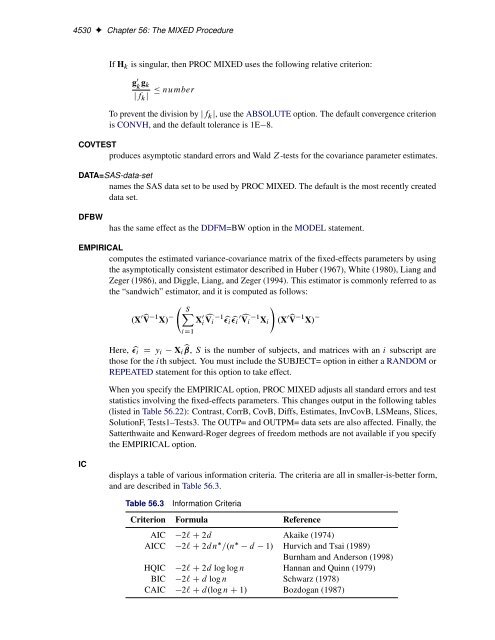SAS/STAT 922 User's Guide: The MIXED Procedure (Book Excerpt)
SAS/STAT 922 User's Guide: The MIXED Procedure (Book Excerpt)
SAS/STAT 922 User's Guide: The MIXED Procedure (Book Excerpt)
Create successful ePaper yourself
Turn your PDF publications into a flip-book with our unique Google optimized e-Paper software.
4530 ✦ Chapter 56: <strong>The</strong> <strong>MIXED</strong> <strong>Procedure</strong><br />
If H k is singular, then PROC <strong>MIXED</strong> uses the following relative criterion:<br />
g 0<br />
k g k<br />
jf kj<br />
number<br />
To prevent the division by jf kj, use the ABSOLUTE option. <strong>The</strong> default convergence criterion<br />
is CONVH, and the default tolerance is 1E 8.<br />
COVTEST<br />
produces asymptotic standard errors and Wald Z-tests for the covariance parameter estimates.<br />
DATA=<strong>SAS</strong>-data-set<br />
names the <strong>SAS</strong> data set to be used by PROC <strong>MIXED</strong>. <strong>The</strong> default is the most recently created<br />
data set.<br />
DFBW<br />
has the same effect as the DDFM=BW option in the MODEL statement.<br />
EMPIRICAL<br />
computes the estimated variance-covariance matrix of the fixed-effects parameters by using<br />
the asymptotically consistent estimator described in Huber (1967), White (1980), Liang and<br />
Zeger (1986), and Diggle, Liang, and Zeger (1994). This estimator is commonly referred to as<br />
the “sandwich” estimator, and it is computed as follows:<br />
IC<br />
.X 0bV 1 X/<br />
SX<br />
iD1<br />
X 0 i cVi 1 bi bi 0cVi 1 Xi<br />
!<br />
.X 0bV 1 X/<br />
Here, bi D yi Xi bˇ, S is the number of subjects, and matrices with an i subscript are<br />
those for the ith subject. You must include the SUBJECT= option in either a RANDOM or<br />
REPEATED statement for this option to take effect.<br />
When you specify the EMPIRICAL option, PROC <strong>MIXED</strong> adjusts all standard errors and test<br />
statistics involving the fixed-effects parameters. This changes output in the following tables<br />
(listed in Table 56.22): Contrast, CorrB, CovB, Diffs, Estimates, InvCovB, LSMeans, Slices,<br />
SolutionF, Tests1–Tests3. <strong>The</strong> OUTP= and OUTPM= data sets are also affected. Finally, the<br />
Satterthwaite and Kenward-Roger degrees of freedom methods are not available if you specify<br />
the EMPIRICAL option.<br />
displays a table of various information criteria. <strong>The</strong> criteria are all in smaller-is-better form,<br />
and are described in Table 56.3.<br />
Table 56.3 Information Criteria<br />
Criterion Formula Reference<br />
AIC 2` C 2d Akaike (1974)<br />
AICC 2` C 2dn =.n d 1/ Hurvich and Tsai (1989)<br />
Burnham and Anderson (1998)<br />
HQIC 2` C 2d log log n Hannan and Quinn (1979)<br />
BIC 2` C d log n Schwarz (1978)<br />
CAIC 2` C d.log n C 1/ Bozdogan (1987)

















